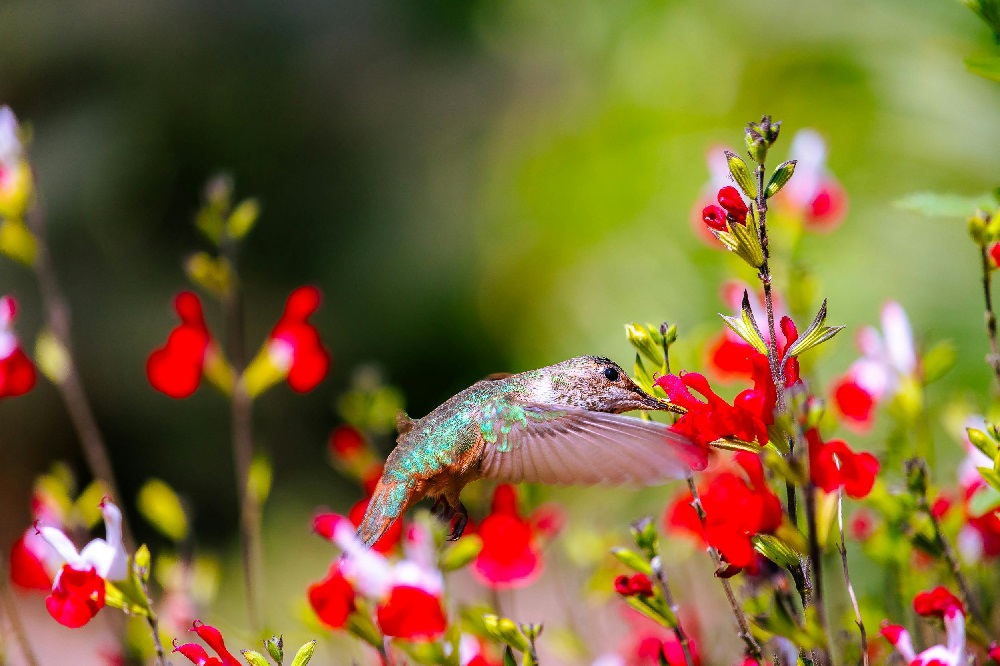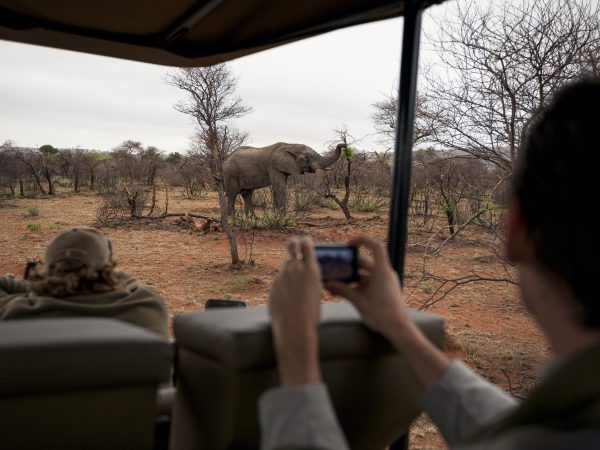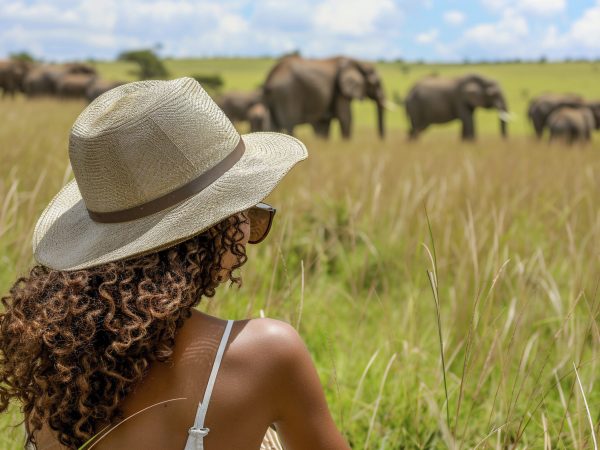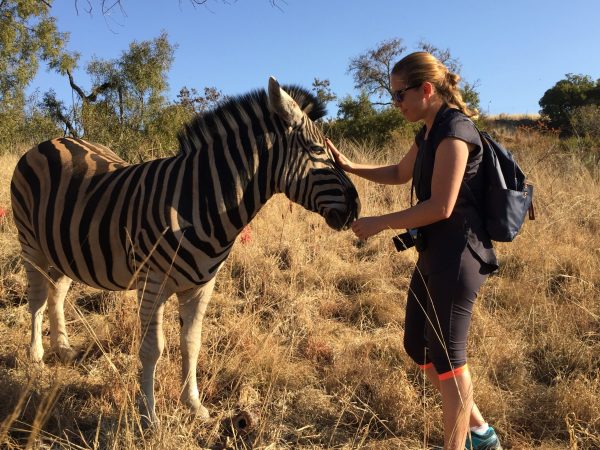Day 1: Nairobi to Meru National Park
Your Kenya Safari Trip begins in Nairobi, a city where modern skyscrapers, bustling markets, and the warm hospitality of its people set the stage for the adventure ahead. As the first light of dawn breaks over the capital, your driver-guide meets you at your hotel or directly at the airport, welcoming you with the kind of friendliness that Kenya is famous for. You board your customized 4×4 safari vehicle, camera in hand, ready to begin a journey that promises not only wildlife encounters but also the thrill of capturing them through your lens.
The road from Nairobi to Meru National Park winds through diverse landscapes that already give you a sense of the country’s variety. As you leave the city behind, you pass fertile farmlands where locals tend to coffee, tea, and banana plantations. The patchwork of fields glistens in the morning sun, and already you’ll want to take photos of the daily life that forms part of the story of any Kenya Safari Trip. Along the way, you keep an eye on the skies, because even before you reach Meru, raptors like the Augur buzzard and Long-crested eagle can be spotted soaring above the road. Their wide wings cut elegant shapes against the blue sky, and your guide slows the vehicle when possible so that you can capture these early photographic opportunities.
By midday, you arrive at the gates of Meru National Park. Known as one of Kenya’s hidden gems, Meru is less visited than the famous Masai Mara or Amboseli, which makes it ideal for photographers who want space, quiet, and uncluttered views of wildlife. After a quick check-in at Ikweta Safari Camp, where a delicious lunch is served, you head out for your first game drive inside the park. The excitement builds as you enter a landscape of rolling savannah, winding rivers, and thick bushland, all teeming with life.
For bird photographers, Meru is a paradise. Among the first species you might see is the Lilac-breasted roller, perched on a branch with feathers that gleam turquoise, purple, and emerald in the sunlight. This bird has become almost symbolic of a Kenya Safari Trip because of its stunning colors and its habit of performing acrobatic dives in the air. With your zoom lens ready, you capture the roller mid-flight, its wings flashing in vibrant hues against the golden grasses.
Moving deeper into the park, your guide points out Grey crowned cranes, elegant birds with golden feathery crowns that dance in pairs, their movements graceful and mesmerizing. Nearby, a Secretary bird strides purposefully through the grass, its long legs carrying it with surprising speed as it searches for snakes. For a bird photographer, these species alone would be enough to fill memory cards, but Meru offers so much more. Elephants move slowly through the bush, Grevy’s zebras—rare and striking with their thin stripes—graze quietly, and reticulated giraffes lift their patterned necks high into the trees. Every corner offers a new subject, a new composition, and a new chance to practice the craft of wildlife photography.
As the afternoon draws to a close, the sky shifts into shades of orange, pink, and purple. The sunset in Meru is breathtaking, and you position your camera to capture the silhouettes of acacia trees against the glowing horizon. The birds, too, put on a show at dusk—flocks of starlings wheel through the air, and eagles return to their roosts for the night. The golden light bathes everything in a soft glow, making your images come alive. By the time you return to camp for dinner, you already feel that the first day of your Kenya Safari Trip has given you more than you expected.
The evening at Ikweta Safari Camp is peaceful. After a hearty meal, you sit by the fire with your guide and fellow travelers, reviewing photos on your camera and sharing stories of the day’s sightings. The sounds of the African night surround you—crickets chirping, distant calls of hyenas, and the soft rustle of leaves in the wind. When you finally retreat to your tent, the excitement of what lies ahead lulls you into a restful sleep.
Accommodation: iKWETA Safari Camp
Day 2: Meru National Park Game Drive
The second day of your Kenya Safari Trip begins with the call of birds outside your tent. The air is cool and fresh as you sip your early morning coffee, knowing that this is the best time to be out in the bush. After breakfast, you set off for a full day of exploration inside Meru National Park, a park celebrated not just for its wildlife but for its role in conservation history—it was here that George and Joy Adamson raised Elsa the lioness, made famous in the book and film “Born Free.”
For bird enthusiasts, Meru is a goldmine. Along the rivers that crisscross the park, you watch the African fish eagle swoop gracefully to snatch fish from the water, its sharp cry echoing through the air. Nearby, Red-necked falcons patrol the skies, their sleek forms slicing against the morning light. On the open plains, Somali ostriches stride proudly, their long legs and graceful necks giving them an almost prehistoric look. Photographing them as they run is both a challenge and a thrill—their speed and movement demanding quick reflexes and patience.
Your guide knows the park intimately, stopping at waterholes and dense thickets where bird activity is high. Bee-eaters flash their colors as they dart after insects, weavers construct elaborate nests that hang from branches like ornaments, and hornbills perch noisily in the trees. Each sighting deepens your appreciation for the diversity of birdlife that makes a Kenya Safari Trip so rewarding for photographers.
Of course, Meru is also home to mammals that demand your attention. Lions may be spotted resting in the shade, cheetahs scanning the plains for prey, and elephants moving in family herds, their calves playing under the watchful eyes of adults. Grevy’s zebras, with their unique stripes, offer fantastic photographic subjects, especially against the contrasting colors of the savannah. Reticulated giraffes, unique to northern Kenya, stretch their patterned necks toward the treetops, creating elegant shapes perfect for your camera frame.
Lunch is enjoyed picnic-style within the park, giving you uninterrupted hours to stay close to the wildlife. Sitting under the shade of a tree, you review your morning shots, sharing tips with your guide about angles, light, and composition. The afternoon continues with more game drives, focusing on areas where bird activity peaks as the day cools.
As sunset approaches, you once again prepare to capture the magic of Meru’s skies. This time, perhaps it is a pair of crowned cranes flying across the horizon or the silhouette of a Secretary bird perched against the fading light. By the time you return to camp for dinner, you feel deeply immersed in the rhythm of the bush. Two days in Meru have already given you a portfolio of images and the sense that this Kenya Safari Trip is truly something special.
Accommodation: iKWETA Safari Camp
Day 3: Meru to Ol Pejeta Conservancy
On the third day, you wake with excitement because today’s journey takes you from Meru to Ol Pejeta Conservancy, one of Kenya’s most innovative conservation projects. After breakfast, you bid farewell to Meru and set out westward, passing through small towns and rolling farmland. Along the way, you watch for roadside raptors perched on telephone poles or hovering above fields—photographic opportunities that remind you that a Kenya Safari Trip offers moments at every turn, not just inside the parks.
By late morning, you arrive at Ol Pejeta Conservancy. Famous for its population of black and white rhinos, as well as the last two remaining northern white rhinos in the world, Ol Pejeta is both a sanctuary and a haven for photographers. But this conservancy is not only about mammals; it is also a birding hotspot. After checking in at Maisha Sweetwaters Camp and enjoying lunch, you head out for an afternoon game drive.
The golden light of late afternoon makes this the perfect time for photography. Among the first birds you may encounter are Jackson’s hornbills, with their distinctive curved bills and striking markings. Northern white-crowned shrikes flit among the branches, while Grey-headed kingfishers perch patiently near water sources, their vibrant plumage a delight for photographers. Capturing these species requires patience and timing, but that is exactly what makes a photography-focused Kenya Safari Trip so rewarding.
Alongside the birds, the conservancy teems with wildlife. Elephants roam across the plains, lions patrol their territories, and herds of antelopes graze peacefully. The conservancy also provides opportunities to photograph chimpanzees, a unique addition to your portfolio. Combining birds and mammals in one setting makes Ol Pejeta one of the most diverse stops on your journey.
As the sun sets, you capture silhouettes of acacia trees, rhinos grazing in the distance, or flocks of birds heading to their roosts. Returning to camp, you enjoy dinner under the stars, the air cool and fresh, the sounds of nocturnal animals drifting across the night. You retire to your tent knowing that today you’ve added another chapter of extraordinary images to your growing collection. This day underscores why a Kenya Safari Trip that combines Meru with Ol Pejeta is such a powerful experience—wildlife, birds, and conservation stories all merge into one seamless adventure.Accommodation: Maisha Sweetwaters Camp
Day 4: Ol Pejeta Conservancy to Lake Nakuru National Park
The fourth day of your Kenya Safari Trip begins at Ol Pejeta with the sounds of nature waking around your camp. As dawn breaks, you step out to the cool morning air and enjoy a warm breakfast while watching the plains come alive with wildlife. Soon after, you set off on the next stage of your journey—heading to Lake Nakuru National Park, one of the most famous birding and photography destinations in Kenya.
The drive takes you across the highlands and into the Great Rift Valley, a journey that in itself offers plenty of photography opportunities. Rolling farmlands, hills dotted with acacia, and the occasional roadside market where locals sell fruits and crafts provide insight into Kenyan life beyond the reserves. Along the way, you may spot raptors perched on poles, bee-eaters darting through the skies, or herons in wetlands by the roadside. Even outside the national parks, a Kenya Safari Trip keeps your eyes glued to the window, ready to capture fleeting moments of beauty.
By mid-morning, you arrive at the gates of Lake Nakuru National Park. Famous for its flamingoes, rhinos, and rich birdlife, Nakuru is a photographer’s paradise. After checking in at Lake Nakuru Lodge and having lunch, you set out for an afternoon game drive that focuses on both the birdlife and larger wildlife of the park.
The highlight for most visitors to Lake Nakuru is, of course, the flamingoes. Thousands of Lesser and Greater flamingoes gather along the lake’s alkaline shores, their pink plumage turning the water into a shimmering carpet of color. Photographing them is an unforgettable experience—whether capturing them in flight as they take off in a pink cloud, or focusing on close-up details of their curved bills as they filter-feed. For many photographers, this scene becomes one of the iconic images of their Kenya Safari Trip.
But flamingoes are only part of the spectacle. Nakuru is also home to pelicans gliding gracefully across the lake, spoonbills wading in the shallows, and cormorants spreading their wings to dry in the sun. Along the forested edges, you may encounter Narina trogons, known for their dazzling colors, or the striking Spectacled weaver weaving its intricate nests. The diversity ensures that every turn of the track offers new photographic opportunities, whether you’re shooting wide landscapes of the lake or close portraits of individual species.
Lake Nakuru is also a sanctuary for both black and white rhinos. Seeing a rhino grazing calmly with flamingoes in the background creates powerful compositions that few other places can offer. Lions, leopards, and buffalo add to the mix, ensuring that your Kenya Safari Trip delivers big game alongside birds. As the sun begins to set, the golden light reflects on the lake, creating mirror-like images of birds in flight.
Returning to Lake Nakuru Lodge for dinner, you feel that today has been one of the richest yet. Reviewing your photos by the fire, you marvel at the range of subjects—from flamingoes and pelicans to rhinos and lions—all captured in one day. Nakuru has proven that bird photography does not mean sacrificing big-game experiences; instead, it enriches them, making your Kenya Safari Trip both comprehensive and unforgettable.
Accommodation: Lake Nakuru Lodge
Day 5: Lake Nakuru to Maasai Mara National Reserve
On day five, you wake early at Lake Nakuru Lodge and enjoy breakfast while the sun rises over the lake. Today’s destination is the legendary Maasai Mara, a place that epitomizes the dream of a Kenya Safari Trip. After checking out, you embark on the drive south toward the Mara, passing through scenic landscapes of rolling hills, farmland, and small Maasai villages. Along the way, you keep your camera ready, because even the journey itself offers glimpses of birds like kestrels hovering above the fields or storks feeding in roadside wetlands.
Arriving at the Maasai Mara by midday, you check in at Jambo Mara Safari Lodge, where lunch awaits. After a brief rest, you head out for your first game drive in this world-famous reserve. The open plains of the Mara stretch endlessly before you, dotted with acacia trees and alive with wildlife. For bird enthusiasts, the Mara offers species that thrive in the open savannah. You may encounter the impressive Kori bustard, Africa’s heaviest flying bird, striding across the grass. Saddle-billed storks stand elegantly near wetlands, while Martial eagles soar high above, their sharp eyes scanning for prey.
The Mara is also about the drama of predator and prey. Lions rest under trees, cheetahs perch on termite mounds, and leopards lurk in riverine forests. Capturing these moments alongside birds creates a portfolio that reflects the true diversity of a Kenya Safari Trip. The afternoon light is perfect for photography, casting a warm glow over the plains and highlighting the details of every feather, mane, and horn.
As sunset paints the horizon, you focus your lens on silhouettes—perhaps a stork flying across the orange sky or a giraffe walking gracefully against the fading light. Returning to your lodge, dinner is served in a lively atmosphere where stories of the day’s sightings are exchanged. The Maasai Mara has already begun to work its magic, proving why it is considered the crown jewel of any Kenya Safari Trip.
Accommodation: Jambo Mara Safari Lodge
Day 6: Maasai Mara Game Drive
Day six is devoted entirely to exploring the Maasai Mara, giving you a full day to immerse yourself in its incredible landscapes and wildlife. Rising before dawn, you head out for a morning game drive when the light is soft and animals are most active. This is the golden hour for photography, and your guide positions the vehicle to take advantage of every opportunity.
Birdlife is abundant in the Mara, and you may begin the day photographing African hoopoes with their striking crests or Yellow-throated sandgrouse camouflaged among the grasses. Wattled plovers call noisily near rivers, while bee-eaters provide flashes of color as they dart after insects. For photographers, the Mara is a place where patience pays off—waiting for a bird to take flight, adjusting angles for the best light, or framing shots with the endless plains as a backdrop.
In addition to birds, the Mara delivers iconic wildlife experiences. Elephants march in family groups, wildebeests graze in large herds, and predators add drama to the day. Perhaps you spot a cheetah chasing gazelles, or lions feeding after a successful hunt. Each sighting adds to the story of your Kenya Safari Trip, reminding you that the Mara is as much about action as it is about serenity.
Midday brings a picnic lunch under the shade of an acacia tree, surrounded by the sights and sounds of the savannah. This pause allows you to review your photos, compare notes with your guide, and prepare for the afternoon drive.
In the afternoon, you may choose to add a hot-air balloon safari, drifting silently over the plains as the sun rises, capturing aerial views of both birds and animals. Photographing from this perspective is a once-in-a-lifetime opportunity that elevates your Kenya Safari Trip to an entirely new level.
As the day ends, you return to your lodge with memory cards full and your spirit uplifted. Dinner is lively, with travelers sharing stories of their encounters, and the night sky sparkles with stars that seem close enough to touch. The Mara has given you a day of endless variety, proving once again why it is considered one of the greatest destinations on earth for both birding and wildlife photography.
Accommodation: Jambo Mara Safari Lodge
Day 7: Maasai Mara to Nairobi
The final day of your Kenya Safari Trip begins with a bittersweet feeling. After breakfast at your lodge, you have the option of visiting a Maasai village before leaving the Mara. This cultural encounter adds another layer to your journey, allowing you to photograph not just wildlife but also the people who have lived alongside it for centuries. Maasai warriors in traditional attire, women adorned in colorful beadwork, and the rhythmic songs and dances of the community provide a vibrant finale to your safari photography.
As you begin the journey back to Nairobi, you keep your camera ready for last-minute captures. Raptors such as the Bateleur eagle may be seen soaring overhead, while vultures perch high in trees, scanning the plains for carrion. These final sightings remind you that a Kenya Safari Trip never truly ends—every moment, even the return drive, offers opportunities for discovery.
Arriving in Nairobi by late afternoon, you are dropped at your hotel or directly at the airport, carrying with you not only thousands of photographs but also the memories of a week spent in some of the most spectacular landscapes on earth. From the hidden beauty of Meru to the conservation efforts of Ol Pejeta, from the flamingo-filled shores of Lake Nakuru to the sweeping plains of the Maasai Mara, this 7-day itinerary has given you the full spectrum of Kenya’s natural and cultural wonders.
It has been more than just a birding adventure. It has been a journey into the soul of Africa, where every sunrise brought new possibilities, every bird told a story, and every photograph became a memory. As you prepare for your onward journey, you know that this Kenya Safari Trip has left an indelible mark on your heart, inspiring you to return again and again to capture the beauty of this incredible land.






